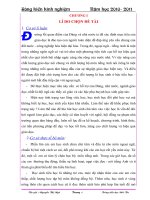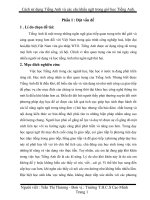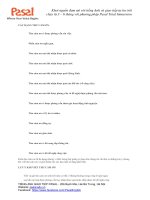Acknowledgement và Table of content (Cách viết lời cảm ơn và trình bày mục lục trong luận văn tiếng Anh)
Bạn đang xem bản rút gọn của tài liệu. Xem và tải ngay bản đầy đủ của tài liệu tại đây (89.95 KB, 4 trang )
Acknowledgement
A completed study would not be done without any assistance. Therefore, the author who
conducted this research gratefully gives acknowledgement to their support and motivation during
the time of doing this research as a requirement of completing my Degree of Business
Management.
First of all, I would like to express my endless thanks and gratefulness to my supervisor Dr.
Abdullah – Al – Mamun. His kindly support and continuous advices went through the process of
completion of my thesis. His encouragement and comments had significantly enriched and
improved my work. Without his motivation and instructions, the thesis would have been
impossible to be done effectively.
As a part of project: Fighting Against Poverty, my thesis has been done by contribution of all
relevant students. So far, I would like to thanks to groups who took charge in the process of data
collection and data entry for doing this research as a part of the project. I also acknowledge my
thankfulness to all respondents and managements’ branches of AIM program where data would
be collected for their valuable time, kind assistances and support in participating in the surveys. I
would like to state my thanks to Binary University College where supported financial for the
project and provided me scholarship to pursuing and completing my degree.
My special thanks approve to my parents for their endless love, care and have most assistances
and motivation me for the whole of my life. I also would like to explain my thanks to my
siblings, brothers and sisters for their support and care me all the time.
As last, my deeply thanks come to all my friends during time I study in Malaysia. Their kindly
help, care, motivation gave me strength and lift me up all the trouble for the rest of my life.
1
Abstracts
Many studies including those by World Bank provided evidence of the positive impact of
microcredit. In most cases, the studies have focused on the direct effects of microcredit on
household income and expenditure. In this study, the author would like to exam the effect of
microcredit on Quality of Life, Vulnerability and Unsatisfied Basic Needs in Urban Malaysia as
a part of study to find out whether this program has positive impact on the clients. The theory is
that the increase in income associated with microcredit scheme increases investigated the
probability that the poor can ease with their current situation.
2
Tables of Contents:
No.
1.
1.0
1.1
1.2
1.3
1.4
1.5
1.6
2.
2.0
2.1.
2.1.1.
2.1.2.
2.1.3.
2.1.4.
2.1.5.
2.1.6.
2.1.7.
2.1.8.
2.1.9.
2.1.10.
2.1.11.
2.1.12.
2.2.
2.2.1.
2.2.2.
2.2.3.
2.2.4.
2.3.
2.3.1.
2.3.2.
2.3.3.
2.4.
2.4.1.
2.4.2.
2.4.3.
2.4.4.
3
Contents
Chapter 1: INTRODUCTION
Introduction
Background of the study
Problem Statement
Research Questions
Research Objectives
Significance of the study
Organization of the study
Chapter 2: LITERATURE REVIEW
Introduction
Poverty and Microcredit
Global poverty Scenario
Definitions of Poverty
Level of Poverty
Indicators of Poverty
How to Reduce Poverty
How Microcredit leads to a decrease in Poverty rate – based on
Income and Asset
Establishment of Microcredit
Microcredit characteristics of Grameen Banks Microcredit
Program and Client Selection Process
Products and Services of Microcredit
Sample Models of Microcredit in The World
Outreach of Microcredit
Impact of Microcredit
Study Contents: Microcredit in Malaysia
Malaysia Economy
Poverty in Malaysia
Poverty Eradicating Policies
Microcredit Organizations in Malaysia
AIM (Amanah Ikhtiar Malaysia)
Background
AIM’s Products and Services
The impacts of AIM’s Services
Review of Methodology
Conceptual Model
Quantitative and Qualitative Study
Question Design
Sample Selection Process
Chapter 3: Research Methodology
Page No.
1
1
3
5
5
6
7
9
10
10
12
14
16
20
21
23
23
26
27
29
30
33
33
34
36
39
45
45
46
51
53
53
55
55
56
3
List of Tables
No.
2.1.1.
2.1.2.
2.2.1.
Contents
Terms Used to Describe Poverty
Results of the Verification Process (12/1999 to 12/2009)
Special Target Group
Page No.
13
30
39
List of Figures
No.
2.1.
2.2.1.
2.4.1.
Contents
Percent of people in the world at different poverty levels in
2005
Malaysia’s GDP (purchasing power parity) in 2007-2009
HOUSEHOLD ECONOMIC PORTFOLIO MODEL
(Chen and Dunn, 1996)
Page No.
11
34
54
4









